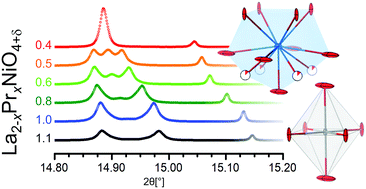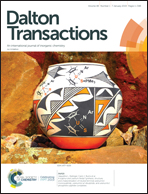Structural transformations of the La2−xPrxNiO4+δ system probed by high-resolution synchrotron and neutron powder diffraction†
Abstract
Compositions in the La2−xPrxNiO4+δ series offer an attractive balance of chemical stability and electrochemical performance for use as cathode materials in solid oxide fuel cells (SOFCs). A detailed crystallographic study of this system has been performed, combining both high resolution synchrotron and neutron powder diffraction data, in order to investigate structural details of the series as a function of composition, temperature and oxygen over-stoichiometry. The monoclinic structure (space group F2/m) of ambient temperature Pr-rich compositions for 1.0 < x ≤ 2.0 is discussed in terms of octahedra tilt arrangements and possible long-range structural modulations. In situ synchrotron diffraction experiments and TEM are employed to examine the role of temperature and interstitial oxygen on these structural distortions. With increasing La substitution, a region of mixed monoclinic and tetragonal phases is described for 0.5 ≤ x ≤ 1.0. La-Rich compositions are found to be single phase tetragonal (F4/mmm for 0 < x < 0.5) or orthorhombic (Fmmm for x = 0). Possible origins and electrochemical property consequences of the refined structural trends are considered.



 Please wait while we load your content...
Please wait while we load your content...